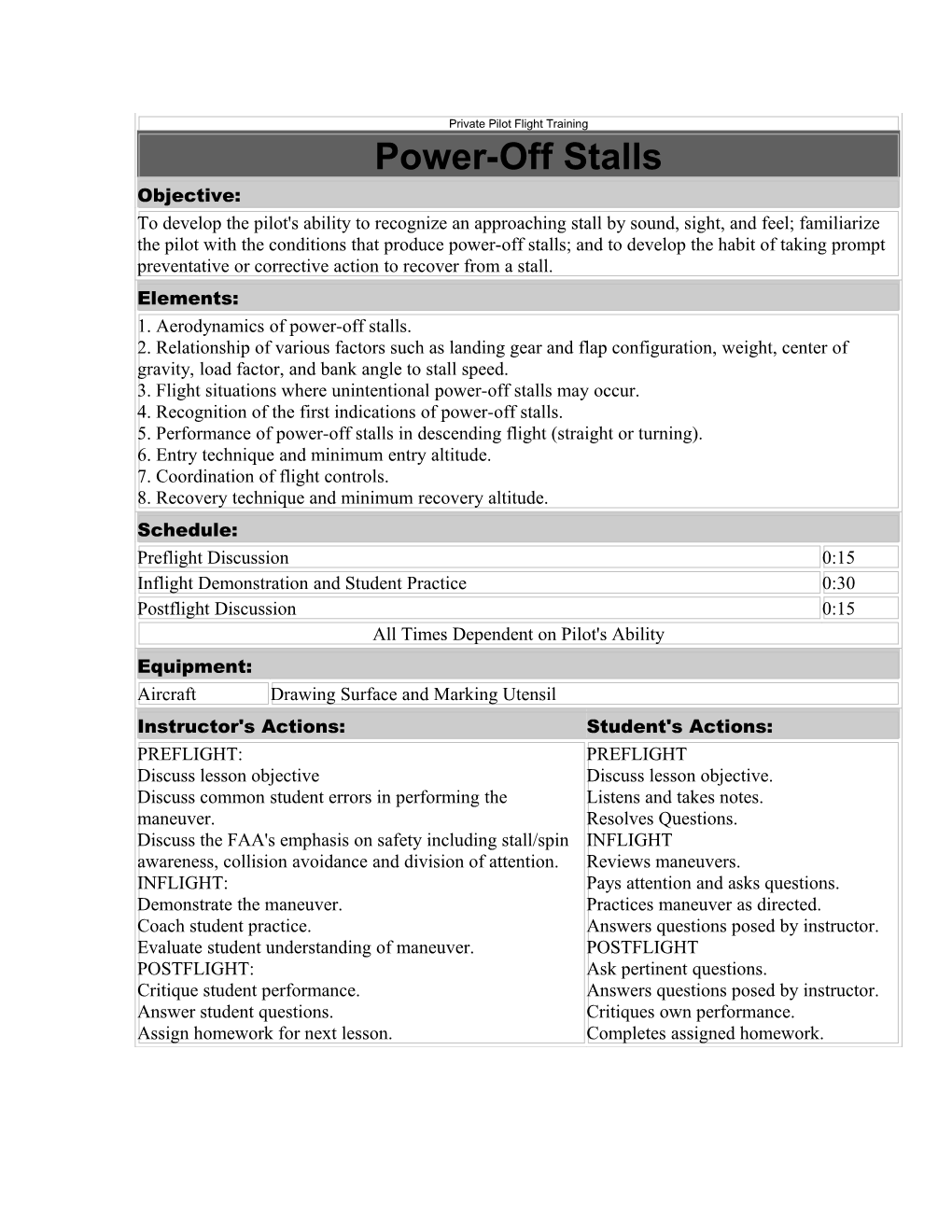Private Pilot Flight Training
Power-Off Stalls
Objective:
To develop the pilot's ability to recognize an approaching stall by sound, sight, and feel; familiarize the pilot with the conditions that produce power-off stalls; and to develop the habit of taking prompt preventative or corrective action to recover from a stall.
Elements:
1. Aerodynamics of power-off stalls.
2. Relationship of various factors such as landing gear and flap configuration, weight, center of gravity, load factor, and bank angle to stall speed.
3. Flight situations where unintentional power-off stalls may occur.
4. Recognition of the first indications of power-off stalls.
5. Performance of power-off stalls in descending flight (straight or turning).
6. Entry technique and minimum entry altitude.
7. Coordination of flight controls.
8. Recovery technique and minimum recovery altitude.
Schedule:
Preflight Discussion / 0:15
Inflight Demonstration and Student Practice / 0:30
Postflight Discussion / 0:15
All Times Dependent on Pilot's Ability
Equipment:
Aircraft / Drawing Surface and Marking Utensil
Instructor's Actions: / Student's Actions:
PREFLIGHT:
Discuss lesson objective
Discuss common student errors in performing the maneuver.
Discuss the FAA's emphasis on safety including stall/spin awareness, collision avoidance and division of attention.
INFLIGHT:
Demonstrate the maneuver.
Coach student practice.
Evaluate student understanding of maneuver.
POSTFLIGHT:
Critique student performance.
Answer student questions.
Assign homework for next lesson. / PREFLIGHT
Discuss lesson objective.
Listens and takes notes.
Resolves Questions.
INFLIGHT
Reviews maneuvers.
Pays attention and asks questions.
Practices maneuver as directed.
Answers questions posed by instructor.
POSTFLIGHT
Ask pertinent questions.
Answers questions posed by instructor.
Critiques own performance.
Completes assigned homework.
Completion Standards:
1. Exhibits knowledge of the elements related to power-off stalls. This shall include an understanding of the aerodynamics of a stall which occurs as a result of uncoordinated flight. Emphasis shall be placed upon recognition of and recovery from a power-off stall.
2. Selects an entry altitude that will allow the task to be completed no lower than 1,500 feet AGL or the recommended altitude, whichever is higher.
3. Establishes a stabilized approach in the approach or landing configuration, as specified by the examiner.
4. Transitions smoothly from the approach or landing attitude to the pitch attitude that will induce a stall.
5. Maintains a specified heading, ±10°, if in straight flight; maintains a specified angle of bank not to exceed 30°, +0/-10°, if in turning flight, while inducing the stall.
6. Recognizes and announces the first aerodynamic indications of the oncoming stall, like buffeting or decay of control effectiveness.
7. Recovers promptly after a stall occurs by simultaneously decreasing the pitch attitude, applying power, and leveling the wings to return to a straight-and-level flight attitude with a minimum loss of altitude appropriate for the airplane.
8. Retracts the flaps to the recommended setting; retracts the landing gear, if retractable, after a positive rate of climb is established; accelerates to Vy before the final flap retraction; returns to the altitude, heading, and airspeed specified by the examiner.
Common Errors:
1. Failure to establish the specified landing gear and flap configuration prior to entry.
2. Improper pitch, heading, and bank control during straight ahead stalls.
3. Improper pitch and bank control during turning stalls.
4. Rough or uncoordinated control technique.
5. Failure to recognize the first indications of a stall.
6. Failure to achieve a stall.
7. Improper torque correction.
8. Poor stall recognition and delayed recovery.
9. Excessive altitude loss or excessive airspeed during recovery.
10. Secondary stall during recovery.
References:
FAA-H-8083-3a / FAA-S-8081-14a (Private PTS, VIII. B. 1-27)
FAA-H-8083-25
Things to Remember:
How this relates to a full-stall landing
To recover from turning and straight imminent and full stalls.
Private Pilot Flight Training s1
